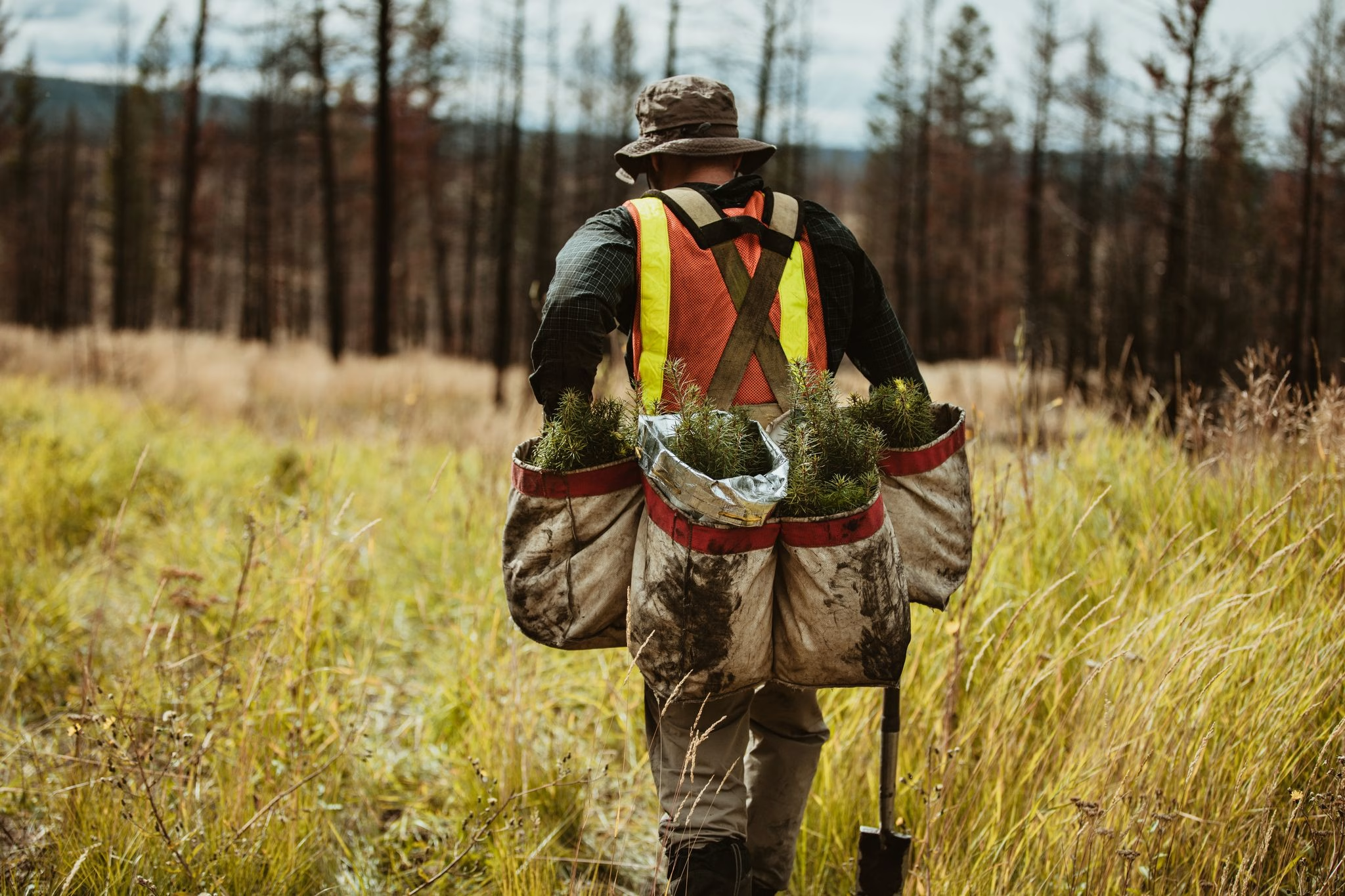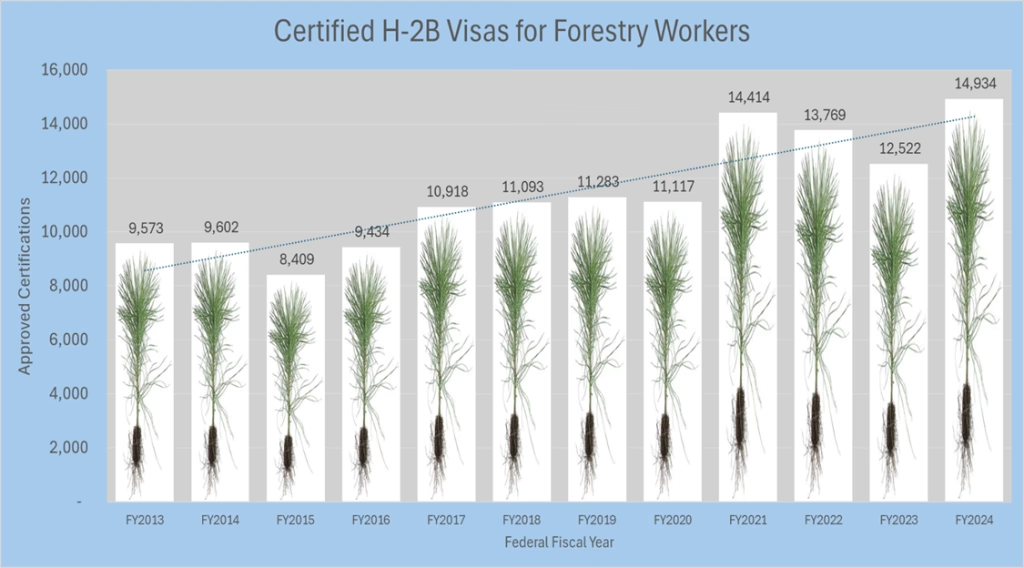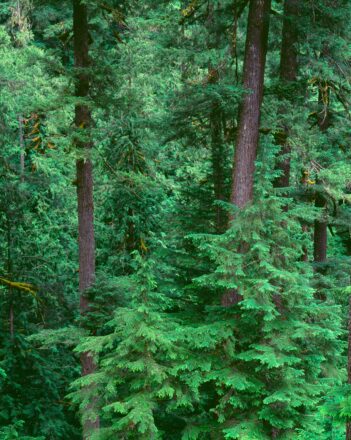Meeting America’s Reforestation Needs

Why the H-2B Visa Program Is More Critical Than Ever
As wildfires continue to reshape America’s forest landscapes, the demand for reforestation has surged—and with it, the need for seasonal forestry workers. The H-2B visa program, which allows U.S. employers to hire foreign workers for temporary non-agricultural jobs, has become essential in restoring public and private forestlands and supporting rural economies.
The Role of H-2B Workers in Forestry
Forestry contractors rely heavily on H-2B workers to perform essential seasonal tasks, including:
- Tree planting after timber harvests or natural disturbances
- Site preparation and vegetation management
- Reforestation of public and private lands
These workers plant over 85% of the trees on U.S. forestlands following a timber harvest or natural disturbance, making them indispensable to national reforestation efforts.
A Growing Backlog of Reforestation Needs
The FRA H-2B Issue Brief highlights a staggering backlog: the USDA Forest Service alone reports over 4 million acres awaiting reforestation. Industry-wide, the delay spans 3–5 years, driven by:
- Increased wildfire activity
- Rising demand for climate-resilient forest management
- Limited domestic labor availability
Without timely reforestation, these lands risk erosion, habitat loss, diminished carbon sequestration capacity, and threaten future timber supply.
Rising Demand for H-2B Visas
The forestry sector isn’t alone in its reliance on H-2B labor. Nationwide, demand for H-2B visas has skyrocketed, with applications far exceeding the annual cap of 66,000. This surge reflects broader seasonal labor shortages in landscaping, hospitality, and construction—but forestry faces unique challenges:
- Short planting windows tied to climate and soil conditions
- Remote work sites with limited local labor pools
- Specialized training and safety requirements
FRA Supported Research
Recent analysis of the H-2B visa program reveals that it does not negatively impact the wages or employment opportunities of U.S. workers in similar occupations. Contrary to common concerns, the presence of H-2B workers does not suppress domestic wages or displace American labor – in fact, the study notes each H-2B worker supports about three to five local U.S. worker jobs, where areas with greater H-2B workers saw wages grow 1.6% higher. Instead, these workers fill critical gaps in seasonal and physically demanding roles that U.S. employers consistently struggle to staff—particularly in industries like forestry, hospitality, landscaping, and seafood processing. Employers must undergo a rigorous labor market test to demonstrate that no qualified U.S. workers are available before hiring H-2B labor, reinforcing the program’s role as a supplement rather than a substitute.
The program is tightly regulated, with an annual cap of 66,000 visas—representing less than 0.1% of total U.S. employment. Despite its limited scale, H-2B labor plays an outsized role in sustaining rural economies and ensuring continuity in seasonal operations. For FRA and its members, the program is especially relevant to seasonal forestry work such as reforestation, wildfire mitigation, and timber stand improvement. Findings from the report support FRA’s strategic advocacy for streamlined visa processing and policy reforms that maintain labor protections while improving responsiveness to industry needs.
FRA Policy Victories
- During the COVID-19 pandemic, FRA successfully advocated for a national interest exception for forestry-related services from the Trump Administration under Proclamation 10052, which had suspended the entry of many nonimmigrant workers into the U.S. This exemption recognized the critical role these workers play in maintaining forest health and supporting wildfire recovery. It also underscored the federal government’s acknowledgment that forestry labor is not only essential but foundational to environmental resilience and rural economic stability. That precedent remains a powerful argument for continued flexibility and prioritization of forestry within H-2B policy discussions.
- Since FY 2017, FRA and its partners have successfully advocated for Congress to let DHS issue extra H-2B visas beyond the cap. Supplemental visas increased from 15,000 in FY2017 to about 70,000 in FY2025.
- In May 2022, FRA secured early H-2B visa releases from the Department of Labor and Homeland Security, which are crucial for timely tree planting during the optimal spring season. These first-half visas ensure that crews are available when conditions are most favorable for seedling survival, helping to avoid delays that can lead to poor establishment, higher mortality, and wasted resources.
Policy Solutions Needed
To meet reforestation goals and support forest health, FRA and its allies in the H-2B Workforce Coalition are advocating for:
- Increased H-2B visa cap flexibility, allowing for immediate release of supplemental visas when the cap is met.
- A permanent fix to the H-2B visa cap.
- An exemption for forestry workers from the H-2B visa cap to address the reforestation backlog.
As policymakers consider reforms to the H-2B program, it’s vital they understand the ecological and economic stakes tied to forestry labor. Reforestation isn’t just about planting trees; it’s about restoring landscapes, protecting watersheds, creating valuable wildlife habitat, increasing carbon sequestration, and sustaining a critical supply of timber resources for future generations.

Figure 1. The number of H-2B forestry workers certified by the Department of Labor is reported by the Federal Fiscal Year. Certification indicates that the employer has met labor market requirements, and the job is classified as temporary non-agricultural work; it does not guarantee the employer will receive workers. After certification, the employer may submit a petition to U.S. Citizenship and Immigration Services (USCIS). USCIS must approve the petition, and the State Department must issue the visa.

